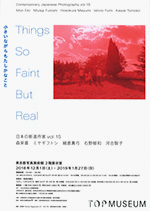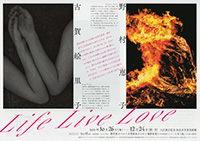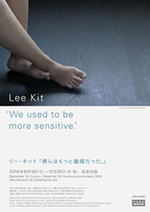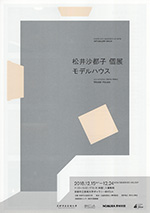 |
Picks is a monthly sampling of Japan's art scene, offering commentary by a variety of reviewers about exhibitions at museums and galleries in recent weeks, with an emphasis on contemporary art by young artists. |
 |
 |
 |
1 February 2019 |
 |
| 1 | 2 | |
 |
|
 |
 |
|
|
 |
|
| Hitomi Akashi: Vagabond's Picture Book |
| 11 - 23 December 2018 |
third district gallery
(Tokyo) |
 |
| Akashi typically aims her camera at people in her immediate vicinity, getting so close she can feel their breath and clicking the shutter in response to their subtlest movements and expressions. The prevalence of nudes in her oeuvre may owe something to the inspiration she derives from the poignancy and tension associated with sexual love. The monochrome images presented here documented her move from Tokyo to Fukuoka, 1,000 kilometers to the south. Their overall mood was bright and positive, an affirmation of her "vagabond" life. |
|
|
 |
 |
|
| Things So Faint But Real: Contemporary Japanese Photography vol. 15 |
| 1 December 2018 - 27 January 2019 |
Tokyo Photographic Art (TOP) Museum
(Tokyo) |
 |
| Since 2002 the TOP Museum has been holding this event to afford promising artists the opportunity to show new works on a common theme; its stated aim is to foster the "creative spirit" in contemporary photography and video art. This 15th installment introduced five artists who use their personal sensibilities or identities as a prism through which to observe and deal with reality and the problems of society. |
|
|

|
 |
 |
|
 |
 |
 |
| Keiko Nomura, Eriko Koga: Life Live Love |
| 26 October - 24 December 2018 |
Irie Taikichi Memorial Museum of Photography, Nara City
(Nara) |
 |
| A joint show by two women photographers. Nomura introduced some dynamic new works shot in a snowbound mountain village, leavening scenes of daily life there with dramatic images of animal carcasses brought in from the hunt and fire festival flames raging against the darkness. Koga presented works from her series Issan, filmed in the Buddhist temple enclave of Mt. Koya, and Tryadhvan, Sanskrit for the "three worlds" of past, present and future. |
|
|
|
|
|
|
|

|
 |
 |
 |
 |
| Technologies for Starting Up vol. 3: Certain Windows |
| 2 November - 24 December 2018 |
Tohoku Research-based Art Center (TRAC)
(Miyagi) |
 |
| Seven years after the Great East Japan Earthquake and Tsunami of March 2011, the artist-researcher group NOOK collected accounts by people in the stricken prefectures of Iwate, Miyagi, and Fukushima of what they had witnessed from "certain windows" along the coast. Photographer Tomomi Morita then captured the views from windows in the region to accompany these recollections. At first glimpse the scenes appear ordinary and undramatic, but the attached texts tell compelling stories that powerfully link landscapes to memories. |
|
|
 |
 |
| Risaku Suzuki: La plaque sensible |
| 28 November 2018 - 16 January 2019 |
Canon Gallery S
(Tokyo) |
 |
| Struck by Paul Cézanne's description of the artist's proper role as that of a "(light-)sensitive plate" (la plaque sensible), Suzuki began photographing landscapes in France and America that have appeared as motifs in various painters' works. In the 23 prints shown here, Suzuki says he sought to express both "nature seen" and "nature felt" by making compositional, focusing, and shutter timing choices that optimize the descriptive power of the large-format camera. |
|

|
 |
 |
 |
 |
|
| Lee Kit: 'We used to be more sensitive.' |
| 16 September - 24 December 2018 |
Hara Museum of Contemporary Art
(Tokyo) |
 |
| Taipei-based artist Lee Kit hails from Hong Kong, a place with a uniquely complicated history that is still in flux today. Using the liberating possibilities of artistic expression to scrutinize himself and the world he lives in, he is noted for site-specific work in which he quietly absorbs the atmosphere and surrounding environment of the exhibiting venue. For this show, his first at a museum in Japan, he created a new installation just for the Hara. |
|
|
 |
 |
 |
| Satoko Matsui: Model House |
| 15 - 24 December 2018 |
@KCUA
(Kyoto) |
 |
| Matsui employs the interior furnishings of standard Japanese living environments as motifs that graphically express their homogeneous superficiality and emptiness, at the same time evoking the abstract structures of minimalist art. In this show she juxtaposed photos of actual model house interiors with an installation of three-dimensional works composed of furnishings and lighting fixtures. |
|
|
|
|
|
|
|
|
|
 |
|